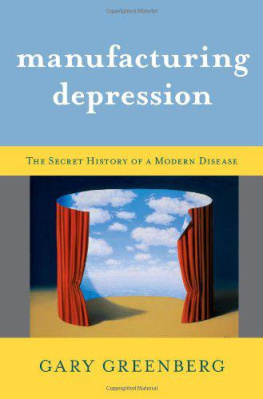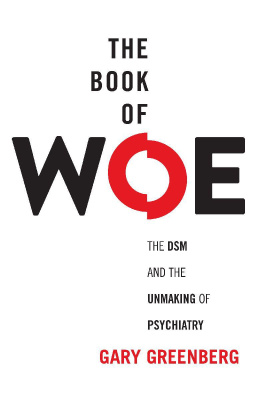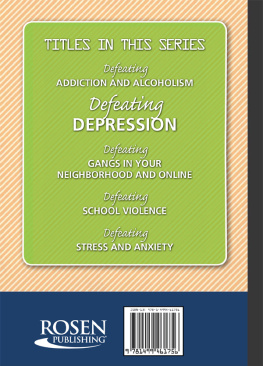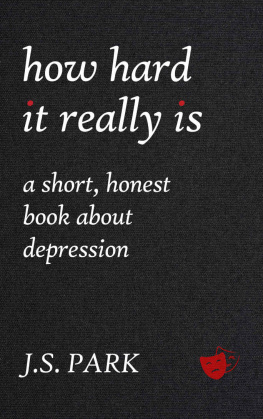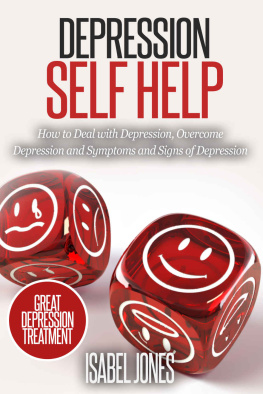
ALSO BY GARY GREENBERG
The Noble Lie
The Self on the Shelf
MANUFACTURING
DEPRESSION
The Secret History of a Modern Disease

Gary Greenberg


Simon & Schuster
1230 Avenue of the Americas
New York, NY 10020
www.SimonandSchuster.com
Copyright 2010 by Gary Greenberg
All rights reserved, including the right to reproduce this book or
portions thereof in any form whatsoever. For information address
Simon & Schuster Subsidiary Rights Department,
1230 Avenue of the Americas, New York, NY 10020.
Certain names and identifying characteristics have been changed, and certain individuals are composites.
Leonard Cohen, Anthem 1992 Sony/ATV Music Publishing LLC. All rights administered by Sony/ATV Music Publishing LLC, 8 Music Square West, Nashville, TN 37203. All rights reserved. Used by permission.
In Memory of Sigmund Freud, copyright 1940 and renewed 1968 by W. H. Auden, from Collected Poems by W. H. Auden. Used by permission of Random House, Inc.
This Be the Verse from Collected Poems, by Philip Larkin. Copyright 1988, 2003 by the Estate of Philip Larkin. Reprinted by permission of Farrar, Straus and Giroux, LLC.
First Simon & Schuster hardcover edition February 2010
SIMON & SCHUSTER and colophon are registered trademarks
of Simon & Schuster, Inc.
For information about special discounts for bulk purchases,
please contact Simon & Schuster Special Sales at
1-866-506-1949 or business@simonandschuster.com.
The Simon & Schuster Speakers Bureau can bring authors
to your live event. For more information or to book an event
contact the Simon & Schuster Speakers Bureau at
1-866-248-3049 or visit our website at www.simonspeakers.com .
Text designed by Paul Dippolito
Manufactured in the United States of America
1 3 5 7 9 10 8 6 4 2
Library of Congress Cataloging-in-Publication Data
Greenberg, Gary, date.
Manufacturing depression: the secret history of a modern disease / Gary Greenberg.
p. cm.
Includes bibliographical references.
1. Depression, MentalUnited StatesHistory. 2. AntidepressantsUnited StatesHistory. I. Title.
[DNLM: 1. DepressionhistoryUnited States. 2. Antidepressive AgentshistoryUnited States. 3. Depressive DisorderhistoryUnited States.
4. PsychotherapyhistoryUnited States. WM 11 AA1 G795m 2010]
RC537.G722 2010
362.25dc22 2009024310
ISBN 978-1-4165-6979-4
ISBN 978-1-4165-7008-0 (ebook)
Ring the bells that can still ring
Forget your perfect offering
There is a crack, a crack in everything
Thats how the light gets in
Leonard Cohen, Anthem
CONTENTS
MANUFACTURING
DEPRESSION
CHAPTER 1
M OLLUSKS
When Betty Twarog opens the door to her cavernous rooms at the University of Maines Darling Marine Laboratory, youre smacked in the face with mist and the smell of brine, and the sound of water everywhere. Pumped out of Boothbay Harbor, it hisses and sprays and gurgles through pipes overhead and sluiceways underfoot, flowing through huge dark tanks full of sea urchins and starfish and other gnarly marine creatures before pouring back into the harbor. With a finger raised to her lips and a sharp shake of her head, she shushes the questions I shout over the din. At first I think she is afraid I will disturb her spat, the baby clams and scallops gestating in the bucket shes leaning over. But, she later explains, her jobto measure out precise portions of the three algae concoctions that are bubbling in tall plastic tuns in an adjacent room and feed them to her tiny chargesrequires her total focus. So for a half hour, she attends to her task with silent concentration. A slightly built woman with ramrod-straight posture and long dark hair drawn back tightly from a dramatic widows peak, she moves with the fluid grace of someone who has been doing chores like these for just over a half century. You wouldnt know it to look at her, but Betty Twarog is seventy-seven years old.
Something else you wouldnt know as she tends her mollusks is that Betty Twarog made one of the most important scientific discoveries of the twentieth century, one that changed the course of neuroscience and medicine and set off a revolution in the way we think of ourselves. In 1952, when she was a twenty-five-year-old woman in a mans world, armed with nothing but a fresh Ph.D. and a hunch about an old scientific mystery, Twarog discovered serotonin in the brain and laid the cornerstone of the antidepressant revolution.
Thats not what she had in mind. All she really wanted to do was to answer in 1884 by Ivan Pavlovyes, that Ivan Pavlovwhen he took a brief excursion into the world of invertebrates. Pavlov, on a postgraduate fellowship in Leipzig, was trying to figure out the secrets of digestion. In large part, moving food along the alimentary tract is a matter of smooth muscle functioning, and Pavlov decided to investigate the byssus retractor, the smooth muscle that Mytilus edulis, the common mussel, uses to close its shell. He was particularly interested in how it was possible for the creature to hold its shell shut against the outside world without expending far more energy than it could possibly take in.
His interest in this question didnt last long, and in the single paper he published on the subject before resuming the inquiries that led to his Nobel Prize (and to his eventual fascination with the salivation reflex in dogs) he offered only the merest hint of an answer. Seventy years later, Betty Twarog, for reasons she cant quite explain, found the remaining mystery irresistible. And she thought she had the answer, but it was too fantastic, too off the charts to be credibleuntil Abbott Pharmaceuticals just happened to mail her the means to check out her hunch.
Abbott had offered samples of a compound it had just synthesized to leading scientists around the country, including John Welsh, Twarogs mentor at Harvard. The molecule didnt have a name yet, or, more accurately, it had a number of them. Chemists called it 5-hydroxytryptamine after its molecular structure. Some biologists were calling it enteramine because they had found it in the guts of squid and octopi, while the biologists who had found it in blood called it serotonin. Abbott wanted the scientists to use their free samples to figure out what exactly the stuff was, what it did, and how it could be used. The company was hoping to find a way to make a drug, or a target for drugs, out of the new compound. They had no idea what they had stumbled upon.
But Twarog did, or so she believed. Pavlov, she thought, had gone much farther toward a solution than he knew. Its perfectly beautiful, Twarog told me, because to this day his paper summarizes the control of these muscles. He insisted that they contract under nervous stimulation and that they hold that contraction until they are signaled by relaxing nerves that turn it off. The mussel, that is, didnt clamp down its byssus retractor and then squeeze it tight like you or I would clench our fist around a quarter; instead, Twarog hypothesized, it closed the shell and threw a lock, which remained latched until a signal opened it like a key.
Twarog, unlike Pavlov, had the benefit of a discovery made in 1921 by a German scientist, Otto Loewi. Loewi wondered exactly how nerves signaled musclesin particular, whether the process was purely electrical or somehow mediated by chemicals. He claimed that an answer came in a dream . He sprang out of bed and rushed to his lab, where he cut the hearts out of two frogs and bathed them separately in salt water. Dissected hearts in saline will continue to beat, and Loewi had left intact the nerves that control the pulse ratethe vagus nerve, which slows it, and the accelerator nerve, which does what you think it does. He sent an electric charge from a battery into the vagus nerve; the heart slowed, just as he expected. But then he took the salt water from that bath and dripped it into the other hearts solution. When that heart slowed without any electrical stimulation, Loewi concluded that a chemical released from the vagus nerve and into the saline, and not electricity, had slowed down the heart. He repeated the experiment on the accelerator nerve, with the same result, and by 5:00 a.m. on Easter Monday had proved the principle of chemical neurotransmission.
Next page
